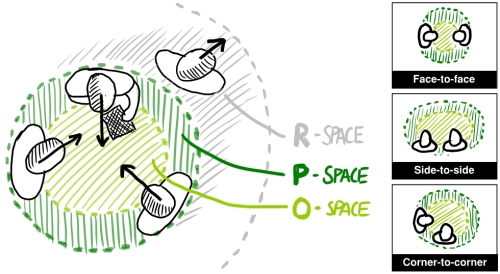My latest paper discussing the GroupTogether system just appeared at the 2012 ACM Symposium on User Interface Software & Technology in Cambridge, MA.
I’m excited about this work — it really looks hard at what some of the next steps in sensing systems might be, particularly when one starts considering how users can most effectively interact with one another in the context of the rapidly proliferating Society of Devices we are currently witnessing.
I think our paper on the GroupTogether system, in particular, does a really nice job of exploring this with strong theoretical foundations drawn from the sociological literature.
F-formations are the various type of small groups that people form when engaged in a joint activity.
GroupTogether starts by considering the natural small-group behaviors adopted by people who come together to accomplish some joint activity. These small groups can take a variety of distinctive forms, and are known collectively in the sociological literature as f-formations. Think of those distinctive circles of people that form spontaneously at parties: typically they are limited to a maximum of about 5 people, the orientation of the partipants clearly defines an area inside the group that is distinct from the rest of the environment outside the group, and there are fairly well established social protocols for people entering and leaving the group.
A small group of two users as sensed via GroupTogether’s overhead Kinect depth-cameras.
GroupTogether also senses the subtle orientation cues of how users handle and posture their tablet computers. These cues are known as micro-mobility, a communicative strategy that people often employ with physical paper documents, such as when a sales representative orients a document towards to to direct your attention and indicate that it is your turn to sign, for example.
Our system, then, is the first to put small-group f-formations, sensed via overhead Kinect depth-camera tracking, in play simultaneously with the micro-mobility of slate computers, sensed via embedded accelerometers and gyros.
GroupTogether uses f-formations to give meaning to the micro-mobility of slate computers. It understands which users have come together in a small group, and which users have not. So you can just tilt your tablet towards a couple of friends standing near you to share content, whereas another person who may be nearby but facing the other way — and thus clearly outside of the social circle of the small group — would not be privy to the transaction. Thus, the techniques lower the barriers to sharing information in small-group settings.
Check out the video to see what these techniques look like in action, as well as to see how the system also considers groupings of people close to situated displays such as electronic whiteboards.
The full text of our scientific paper on GroupTogether and the citation is also available.
My co-author Nic Marquardt was the first author and delivered the talk. Saul Greenberg of the University of Calgary also contributed many great insights to the paper.
Image credits: Nic Marquardt




